View From the Couch: Bad Lieutenant, Godzilla x Kong, Paris Blues, etc.
View From The Couch is a weekly column that reviews what’s new on Blu-ray, 4K and DVD.
 FILM FRENZY
FILM FRENZY
Your source for movie reviews on the theatrical and home fronts
View From The Couch is a weekly column that reviews what’s new on Blu-ray, 4K and DVD.
Paul Newman and Louis Armstrong in Paris Blues (Photo: MGM)
By Matt Brunson
(View From The Couch is a weekly column that reviews what’s new on Blu-ray, 4K and DVD. Ratings are on a four-star scale.)
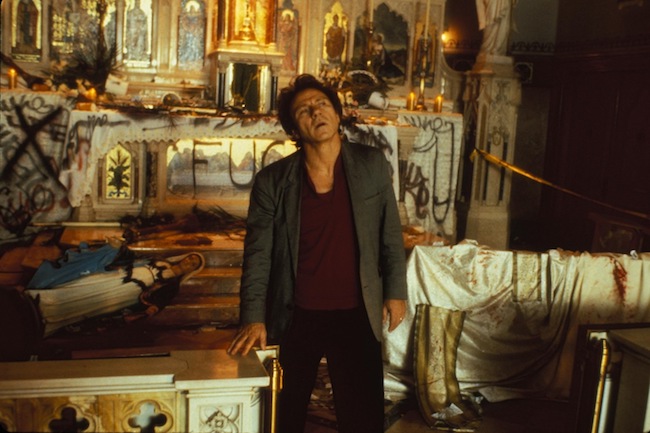
BAD LIEUTENANT (1992). From his Oscar-nominated turn as gangster Mickey Cohen in 1991’s Bugsy to his work as a sympathetic detective in the same year’s Thelma & Louise, from his unexpected casting as the romantic lead in 1993’s The Piano to his memorable bit as The Wolf in 1994’s Pulp Fiction, Harvey Keitel was seemingly everywhere during the 1990s, ultimately appearing in 34 films in that 10-year span. Arguably the most controversial of all his roles from the period was that of the title character in Bad Lieutenant, an NC-17 offering from writer-director Abel Ferrara and co-scripter Zoë Lund. Terrible Lieutenant probably would have been a more accurate title: Full of self-loathing, he drinks too much, shoots heroin occasionally, snorts cocaine always, steals money and evidence, spends more time with hookers than with his own wife and kids, and even blackmails teenage girls into acting lewdly while he masturbates in front of them. He would seem to be incapable of any sort of reflection or redemption, but this Catholic cop ends up experiencing a spiritual crisis of sorts as he investigates the rape of a nun (Frankie Thorn). Martin Scorsese and Keitel explored the subject of religion in 1972’s Mean Streets; Ferrara and Keitel take it a step further, even if Ferrara seems less sincere and more disingenuous than Scorsese in his probing. Keitel’s performance is astonishing, with the actor completely exposing himself physically, mentally, and emotionally.
Extras in the 4K + Blu-ray edition include audio commentary by Ferrara and cinematographer Ken Kelsch; a making-of piece; and a look at some of the locations where this very NYC-flavored film was shot.
Movie: ★★★
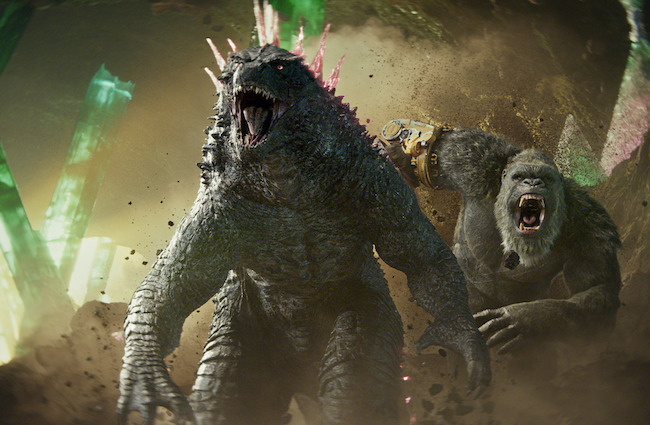
GODZILLA X KONG: THE NEW EMPIRE (2024). Of the four previous Monsterverse pictures, only 2017’s Kong: Skull Island was what I would consider a good (★★★) movie. The nagging feeling that I was a bit too easy on the other entries — 2014’s Godzilla, 2019’s Godzilla: King of the Monsters, and 2021’s Godzilla vs. Kong (all ranked at the low end of ★★½) — was justified due to some fairly compelling monster-on-monster action and the sense (hope?) that the series was building up to something truly spectacular. Based on the evidence of GxK, that’s clearly not gonna happen. This movie’s a mess, and it looks even more puny when compared to last year’s non-related Godzilla Minus One, which deserved both its rave reviews and its Oscar win for Best Visual Effects. This one doesn’t even feel like a creature feature as much as a Transformers sequel: It’s noisy, punishing, soulless (it calculatingly kills off more civilians than even Man of Steel), needlessly convoluted, populated by nitwits and dullards, and choked with increasingly impersonal CGI. Kong retains some personality, and Dan Stevens tries hard to inject some rooting interest into his hippie-dippie character, but not much else works. Kong now lives in the Hollow Earth, which might as well be called Middle-Earth since he hangs around a dewy-eyed critter who looks just like a simian Gollum. Meanwhile, Godzilla is taking a nap in Rome’s Colosseum. Both are forced to spring into action when a new Titan (the name given to all these godlike critters) enters the scene. The slo-mo shots of monsters being macho are laughable; everything else is crass and condescending.
Extras in the 4K Ultra HD+ Digital edition consist of audio commentary by director Adam Wingard and select crew members, and over a dozen making-of featurettes.
Movie: ★½
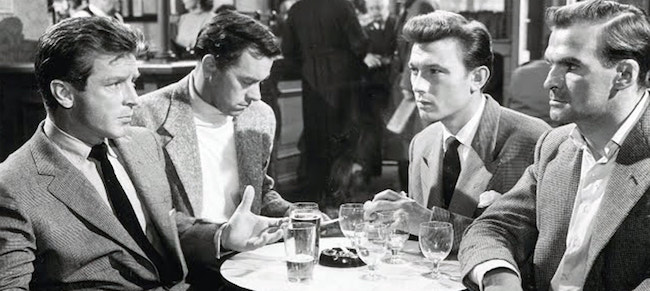
THE GOOD DIE YOUNG (1954). An exceptional cast provides quite the lift to this unevenly paced heist flick directed by future Alfie and James Bond helmer Lewis Gilbert. Laurence Harvey made a career out of playing cads, and his character of Miles “Rave” Ravenscourt proves to be an especially notable rotter. A Londoner who’s hopelessly lazy and prone to gambling and sleeping around, Rave finds himself flailing when his wealthy wife (Margaret Leighton) decides to cut off his funds. He invites three relative strangers to join him in a robbery, and they all accept due to their own struggles: Fellow Brit Mike Morgan (Stanley Baker) is having trouble adjusting to a normal life after years as a boxer, U.S. serviceman Eddie Blaine (John Ireland) is AWOL as he tries to control his trollop wife (Gloria Grahame, of course), and American clerk Joe Halsey (Richard Basehart) must get his pregnant English wife (Joan Collins) away from her unbearably oppressive and demanding mother (Freda Jackson). The tragedy of the tale is that Mike, Eddie, and especially Joe are all decent men, turning to what they believe will be a victimless crime only because their backs are against that proverbial wall. They didn’t count on the fact that Rave is borderline psychotic, willing to kill just about anyone, including them (Robert Morley appears in one scene as Rave’s estranged father, the only person who understands the depths of his son’s derangement). The exposition is handled so well for all four of these amateur criminals that it’s a shame the movie feels rushed post-robbery, without much time to absorb and accept the rapidly escalating turn of events.
There are no Blu-ray extras.
Movie: ★★½

IO CAPITANO (2023). An Academy Award nominee for Best International Feature, this Italian production from writer-director Matteo Garrone (Gomorrah) begins in a peaceful neighborhood in Dakar, Senegal, where teenage cousins Seydou and Moussa (nonprofessional actors Seydou Sarr and Moustapha Fall), both from struggling families, decide to head to Europe with dreams of fame and fortune. The rest of the film basically presents a journey through Hell, as the boys endure all manner of hardships as they attempt to make it to Italy. Armed with the money they’ve saved and departing without telling anyone (Seydou’s worried mother had already put her foot down concerning him leaving), they quickly are confronted by the evils of the world. They fall victim to con artists, corrupt officials, and outlaws who have no problem torturing and killing innocent people for money — even the elements are against them, as witnessed by a punishing slog through the Sahara Desert and a treacherous boat ride across the Mediterranean Sea. For those deeply affected by the horrific stories emanating daily from Ukraine and the Gaza Strip, Io Capitano is not an easy watch, as it unfailingly shows humanity at its absolute worst. The first half is particular wrenching in this regard — in one disturbing sequence, a migrant falls out of a rickety truck as it roughly bounces across the Sahara and the driver-guide refuses to stop to pick him back up, thus leaving him to perish under the hot sun. The harrowing pace slows down during the second half as slivers of salvation begin to form, but the ending should have offered more closure.
Blu-ray extras consist of Q&As with Garrone, Sarr, Fall, and Mamadou Kouassi (the migrant whose own real-life experiences formed the basis for much of the film), and the theatrical trailer.
Movie: ★★★
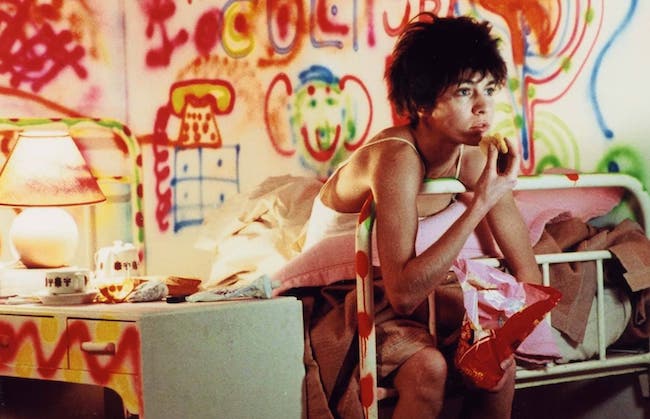
LA FEMME NIKITA (1990). Writer-director Luc Besson (Subway, The Fifth Element) applies his usual slick stylistics to this durable French thriller about a junkie (Anne Parillaud) who kills a cop while under the influence and, once cleaned up, must make a literal life-or-death decision. As a suit named Bob (Tchéky Karyo) explains, Nikita can either be executed for her crime or agree to be reborn as an assassin for a secretive government agency. Naturally, she chooses the latter, with Bob serving as her handler. Once Nikita becomes an expert in weaponry and martial arts — and once her transformation from street punk to elegant beauty is complete (screen veteran Jeanne Moreau plays the agency instructor who teaches her about makeup foundations and feminine wiles) — she ventures into the real world, only to unexpectedly fall in love with an affable, ordinary guy (Jean-Hugues Anglade) even as she’s expected to carry out cold-blooded hits. Parillaud is excellent as a woman who may have grasped the fundamentals of the assassination game but remains emotionally vulnerable underneath, while Jean Reno adds some late-inning intensity as the gruff, no-nonsense Victor “The Cleaner.” Released in France in early 1990, the film reached our shores in early 1991 and was quickly followed by an American remake in 1993 (the so-so Point of No Return, starring Bridget Fonda, Gabriel Byrne as Bob, and Bad Lieutenant’s Harvey Keitel as Victor “The Cleaner”) and by two television series much later.
The new 4K Ultra HD Steelbook edition contains no extras.
Movie: ★★★
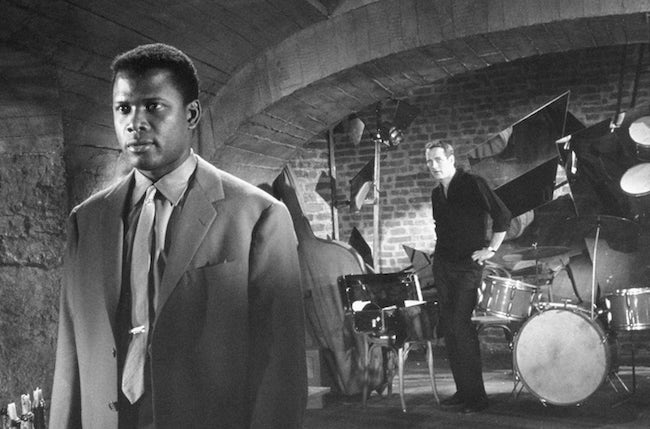
PARIS BLUES (1961) / PRESSURE POINT (1962). Sandwiched between two of Sidney Poitier’s most instantly recognizable films — 1961’s four-star A Raisin in the Sun (reviewed here) and 1963’s Lilies of the Field (reviewed here), the latter for which he became the first black man to win an Academy Award in an acting category — are two comparatively lesser known pictures that nevertheless deserve a look.
Particularly good is Paris Blues, with Poitier and Paul Newman cast as two American jazz musicians enjoying steady employment in the French capital. Newman’s Ram is attempting to write a great musical composition while Poitier’s Eddie appreciates living far away from the racism that would likely define his existence in America. Into their lives come Connie (Diahann Carroll) and Lillian (Joanne Woodward), American tourists who end up getting romantically involved with the musicians. Both want the men to return with them to the U.S., Lillian hoping that Ram will join her and her kids from a previous marriage in domestic bliss and Connie insisting that Eddie needs to come home to help combat prejudice rather than hiding from it in Paris. Flavorfully directed by Martin Ritt (who would collaborate with Newman on six films and with Newman’s wife Woodward on four) and beautifully shot by cinematographer Christian Matras (whose resume merely includes such all-timers of world cinema as Renoir’s Grand Illusion, Ophüls’ The Earrings of Madame De…, and Buñuel’s The Milky Way), Paris Blues feels strikingly original in its ambience, relationships, and dialogue. There’s also an added treat in the casting of the great Louis Armstrong as “Wild Man” Moore, a popular jazz musician who leads Ram and Eddie in “Battle Royal.” (If you can’t make the time for the entire movie, at least catch this astonishing number on YouTube here . And you’re welcome.) Duke Ellington earned an Oscar nomination for his score.
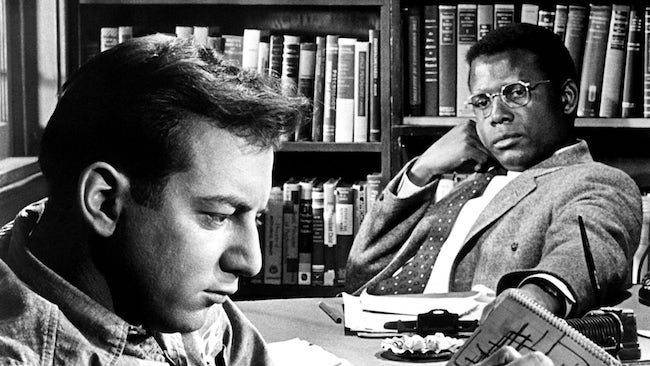
Poitier plays a decidedly different type of character in Pressure Point, a psychological drama based on one of the actual case studies detailed in Robert Lindner’s book The Fifty-Minute Hour. He’s cast as the head of a psychiatric institute whose best doctor (Peter Falk, billed in the credits as “Special Guest Star”) is frustrated by his latest case. This leads Poitier’s doc to relate (via flashback) how, back in 1942, he himself had to deal with a difficult case, as he was a young prison psychiatrist assigned to treat a Nazi sympathizer (Bobby Darin) suffering from recurring nightmares. While not pleased to be given a patient who hates him merely because of the color of his skin, the doctor nevertheless makes a genuine attempt to understand what makes this violent young man tick and in the process perhaps cure him of his maladies. Despite a few outdoor sequences and some moments set at a German American Bund meeting, the otherwise limited setting and relatively small cast make this feel like a filmed stage production, but the intimate nature allows for a greater focus on the battle of wills between the dedicated doctor and the antagonistic inmate. Darin is particularly impressive as the odious white supremacist — a year later, he would be earning a Best Supporting Actor Oscar nomination for playing another, albeit far more likable, WWII psychiatric patient, this time opposite Gregory Peck’s title shrink in Captain Newman, M.D. (reviewed here).
There are no extras on either Blu-ray release.
Paris Blues: ★★★½
Pressure Point: ★★★
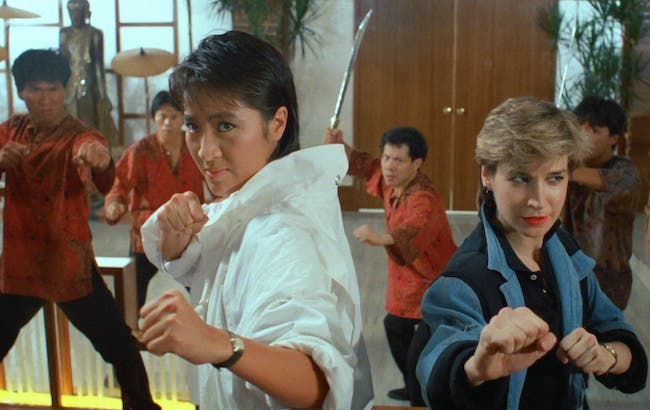
YES, MADAM! (1985) / ROYAL WARRIORS (1986). Please pay attention, because there might be a quiz later. The Hong Kong martial arts flick Yes, Madam! was released in 1985 while Royal Warriors was released in 1986. But Royal Warriors was also given the title (particularly in foreign markets) In the Line of Duty, and when the movie proved to be a major hit, the powers-that-be decided to inaugurate a new film franchise with it — thus, they went back and renamed Yes, Madam! In the Line of Duty II even though it had been released before Part I. Ultimately, there were nine films in the series, although title consistency was never a strong point. In England, both Yes, Madam! and Royal Warriors were called Police Assassins (someone eventually thought to add a II at the end of one of the titles), while the ninth film in the series somehow ended up with the moniker Yes Madam 5. Most employed the In the Line of Duty franchise tag in the header (such as In the Line of Duty 5: Middle Man), although some didn’t even bother (the seventh film, for instance, was only called Sea Wolves).
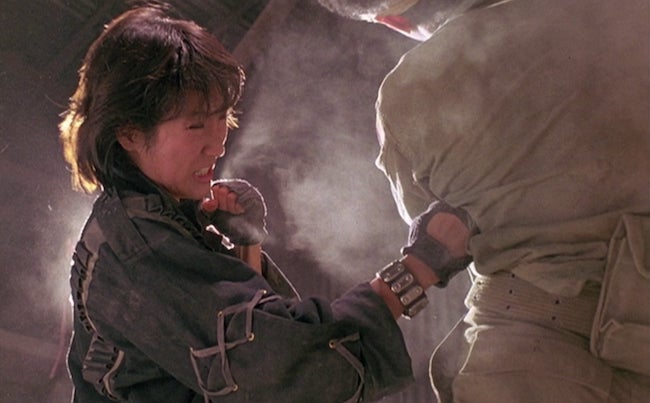
Anyway! Last year, 88 Films released a Blu-ray box set featuring the first four films in the series, and now the outfit has released individual Blus for the first two pictures, the only ones to star Everything Everywhere All at Once Oscar winner Michelle Yeoh (back when she was still billing herself as Michelle Khan). In Yes, Madam!, she plays Senior Police Inspector Ng, who teams up with Scotland Yard Inspector Carrie Morris (Cynthia Rothrock) to stop a crime syndicate responsible for the murder of a British agent. Complicating matters is the presence of a trio of bumbling thieves who are in possession of some microfilm sought by all. The fight sequences are top-notch, and the antics of the crooks (who command as much screen time as the leading ladies) are amusing, with Tsui Hark a standout as the shiftiest of the three. Royal Warriors, meanwhile, opens with a spectacular set-piece set aboard an airplane, but the movie soon loses altitude due to one particularly annoying character and a surprisingly sadistic streak that runs throughout. Yeoh here plays a detective who teams with two other law officers, the obnoxious Michael (Michael Wong) and the taciturn Peter (Hiroyuki Sanada), to stop an airplane hijacking, a noble act that results in the friends of the perpetrators targeting all three for revenge.
Blu-ray extras on both titles include audio commentary by Hong Kong film expert Frank Djeng and trailers. Yes, Madam! also numbers among its bonus features an interview with Rothrock and an archival interview with Yeoh, while Royal Warriors offers additional shots from the airplane sequence as well as the English In the Line of Duty titles.
Yes, Madam!: ★★★
Royal Warriors: ★★½
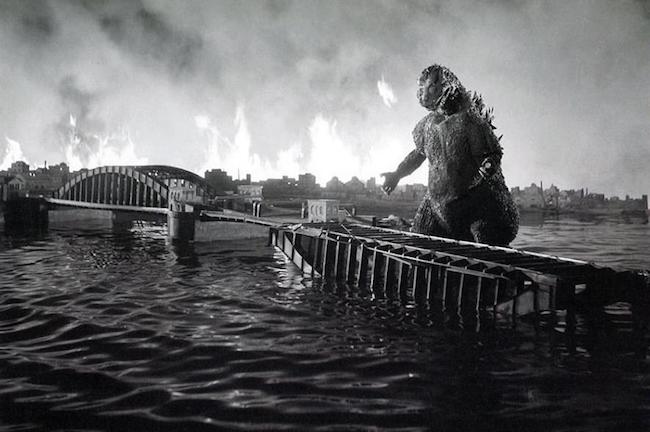
FROM SCREEN TO STREAM
GOJIRA (1954) / GODZILLA, KING OF THE MONSTERS! (1956). A double feature of the Japanese-language Gojira and the English-language Godzilla, King of the Monsters! might seem redundant, but their differences can be so startling that it’s almost like watching two different films. A twin viewing might also make it easier to understand how and why drastic changes were made to the original before its US launch. When Gojira (a.k.a. Godzilla) premiered in Japan in 1954, it was hardly viewed as a run-of-the-mill monster movie. Instead, this tale about a rampaging behemoth terrorizing Tokyo was its makers’ fantasy-veiled look at the evils of nuclear power — a direct statement against the bombings of Hiroshima and Nagasaki that had marked the final chapter of World War II nine years earlier. The film was a hit in Japan, but before it reached our shores, American distributors knew some changes had to be made. Gone were almost all references to Japan’s recent H-bomb annihilation, as well as numerous talky sequences that were believed would hurt the picture’s stateside success. Trimming around 40 minutes from the 98-minute original, its US handlers then added a little over 20 minutes of newly shot footage featuring Raymond Burr as an American reporter passing through Tokyo at the time of Godzilla’s reign of terror. This version opened stateside in 1956 under the title Godzilla, King of the Monsters! and went on to become an international smash. Certainly, the American cut is a fine example of the sort of sci-fi yarns being produced during the ’50s — and the integration of the new footage into the old is smoothly done — yet it’s the more somber Japanese version (which wasn’t released in the United States until 2004!) that resonates as a true tale of horror rather than just another creature feature.
Gojira: ★★★½
Godzilla, King of the Monsters!: ★★★
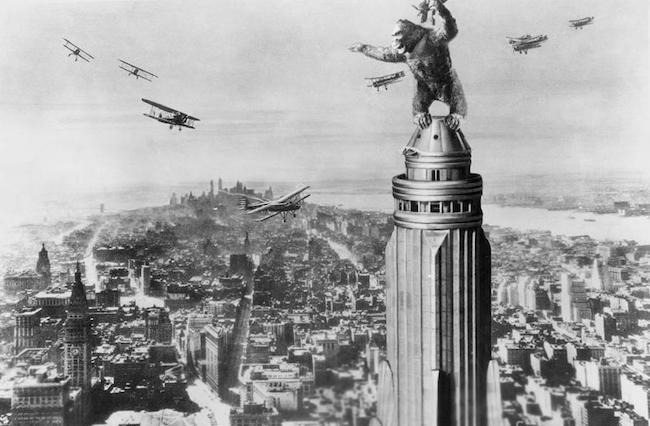
KING KONG (1933). A gargantuan hit upon its original release and subsequent reissues, King Kong goes beyond being a mere staple of film history. In much the same manner as The Wizard of Oz and It’s a Wonderful Life, this masterpiece about “The Eighth Wonder of the World” long ago entered into the national consciousness as an enduring part of our heritage. As Ann Darrow, the beauty who captures the beast’s oversized heart, Fay Wray became an overnight star, although equally memorable is Robert Armstrong as Carl Denham, the boisterous filmmaker who sets the story in motion with his plan to shoot his next exotic picture on the uncharted Skull Island. Under the auspices of producer-directors Merian C. Cooper and Ernest B. Schoedsack, Willis O’Brien (with a major assist from Marcel Delgado) contributed extraordinary stop-motion effects that brought to life many classic sequences, including Kong’s destruction of a native village, his battles with prehistoric beasts, and his tragic last stand atop the Empire State Building. O’Brien’s effects were both innovative and influential — the same goes for Max Steiner’s excellent music, generally credited not only as one of the very first feature-length movie scores but also one of the earliest to employ a full symphony. (For more monkey business, check out the placement of 16 KK-related films in King Kong: Ranking the Giant Ape Films here).
Movie: ★★★★